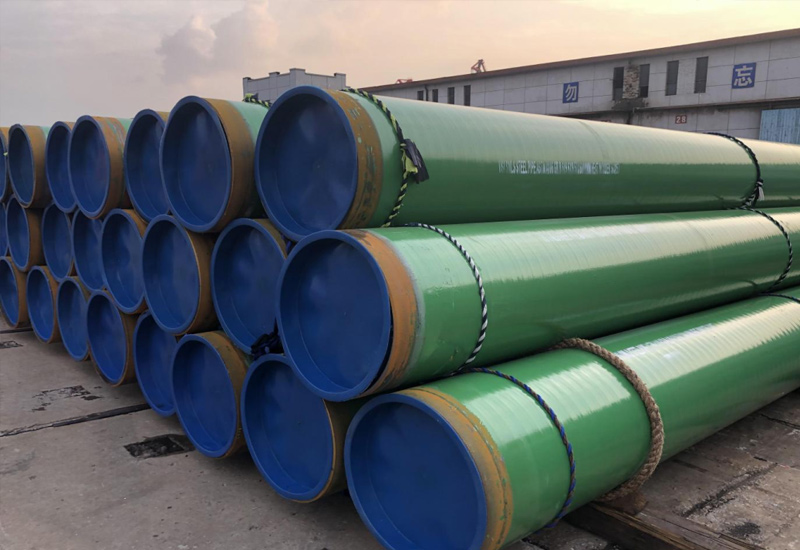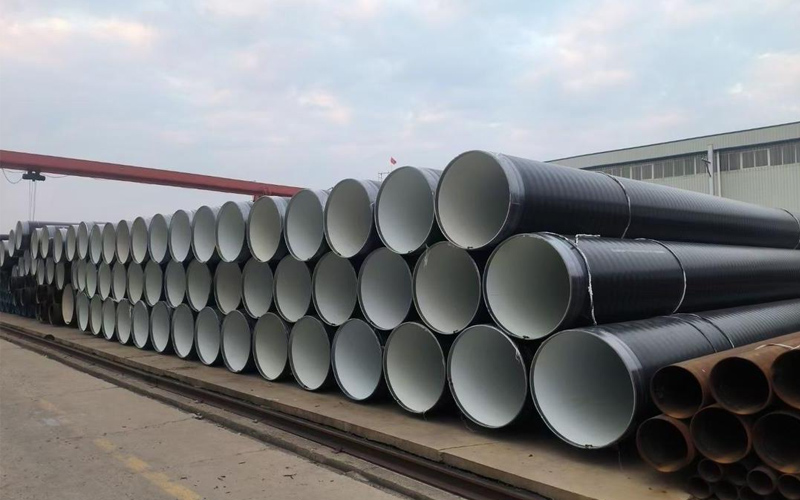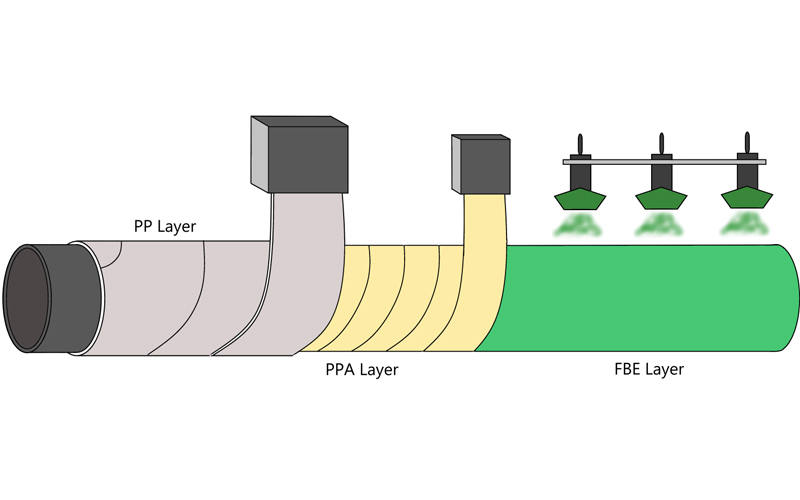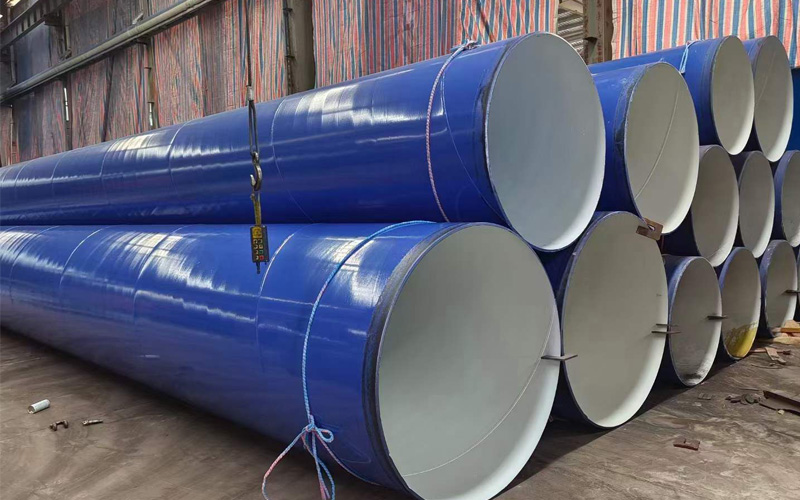3LPE coated steel pipe: a solid barrier in the field of industrial corrosion protection
In the harsh environment of oil and gas, chemical industry, urban pipe network, etc., the long-term reliability and corrosion resistance of pipeline system is very important. 3LPE coated steel pipe (Three Layer Polyethylene) has become the preferred anti-corrosion solution for long-distance pipeline transportation due to its excellent protection ability.
1. Coating material and precision production
The core of 3LPE coated steel pipe lies in its unique three-layer composite structure, each layer has a key mission:

The base layer (FBE-Fusion Bonded Epoxy) is a thin, highly effective coating (typically 100-250 microns thick) directly applied to the surface of a rigorously treated steel pipe. This layer provides excellent electrochemical corrosion protection (high resistance to cathodic stripping) and exceptional adhesion to the steel substrate, forming the foundation of the entire 3LPE coating system.
Middle layer (Adhesive): A special copolymer adhesive layer. It can simultaneously react with FBE of the bottom layer and polyethylene of the surface layer in the molten state, and form a strong bonding bridge, ensuring that the three layers are tightly combined into one and effectively preventing delamination.
Surface layer (PE-polyethylene): A thick (usually 1.8-3.7mm) tough plastic layer of high density polyethylene (HDPE) or modified polyethylene (MDPE). This layer provides excellent mechanical protection (impact, wear, soil stress), excellent chemical corrosion resistance and good insulation properties, effectively isolating water and corrosive media.
The 3LPE coating process is carried out in a highly automated 3LPE pipe plant with extremely strict quality requirements:
Surface treatment: The steel pipe is thoroughly cleaned (sandblasting to Sa 2.5 level) to achieve the original color of the metal and form the profile of the anchor.
Preheating: The temperature is precisely controlled to ensure good powder melting.
Electrostatic spraying FBE: the underlying FBE is evenly sprayed and melted and solidified.
Extrusion winding of copolymer adhesive: the extruded molten adhesive is applied while the FBE layer is still activated.
Polyethylene layer extrusion coating: the molten polyethylene layer is immediately extruded and tightly coated on the adhesive layer.
Water cooling molding: make 3LPE coated pipe quickly cool and set.
Detection and repair: strict electrical discharge leak detection, thickness measurement, appearance inspection, etc., to ensure that the quality of each 3LPE coating pipe meets the standard. The whole Coating 3LPE process should comply with international standards such as DIN 30670.
2. Performance comparison
The choice of anti-corrosion method has a great impact on the life and operating cost of the pipeline. The following is a key performance comparison:
| performance index | Un–coated steel pipe | FBE coated steel pipe (single layer) | 3LPE coated steel pipe |
| Anti-corrosion life | Extremely short (depends on cathodic protection) | Longer (20-30 years +) | Extremely long (50 years +) |
| Mechanical protection | No | Weak (thin, brittle) | Extremely strong (thick and tough PE layer) |
| Resist cathode stripping | Rely on cathodic protection effect | Outstanding | Excellent (FBE underlying guarantee) |
| resistance to chemical attack | No | Good | Excellent (PE layer strong barrier) |
| abrasion performance | Lowest | Average | Excellent |
| Resistant to soil stress | No | Limited | Excellent (flexible PE layer) |
| Construction damage risk | No applicable | High (thin coating, easy damage) | Low (good resilience) |
| Initial investment cost | Lowest | Secondary | Higher |
| Total life cycle cost | Highest (frequent maintenance and replacement) | Secondary | Minimum (long maintenance free life) |
Clearly, Anti-corrosion 3LPE pipes have a significant advantage in comprehensive protection. Their extended design life and low maintenance requirements make their lifecycle cost significantly lower than that of un-coated steel pipes and single-layer FBE coated pipes. In harsh environments such as rock areas, permafrost zones, high groundwater levels, heavily polluted soil areas, or underwater, 3LPE coated pipes are one of the most reliable choice for ensuring the safe operation of pipelines.
3. Special application scenarios: lifeline in harsh environment
3LPE coated steel pipe is widely used in a variety of special scenes with high requirements due to its unparalleled protective performance:
Long-distance oil and gas pipelines: This is the primary and most critical application area for 3LPE steel pipe. Whether it involves crossing deserts, swamps, and rivers on land or laying under the sea, API 5L 3LPE pipe (a 3LPE pipe that meets the API 5L standard) is essential for ensuring the safety of national energy arteries. Its superior corrosion resistance and mechanical protection effectively prevent soil corrosion, stress cracking, third-party damage, and seawater erosion. Many large-scale pipeline projects worldwide have specified the use of 3LPE coated pipes.
Chemical and industrial pipe network: The process pipeline that transports various corrosive media (such as acid, alkali and salt solution) has extremely high anti-corrosion requirements. 3LPE lined steel pipe or standard 3LPE coated pipe can effectively isolate the corrosion of the medium to the steel pipe and ensure the safe and continuous operation of the factory.
Urban water supply and heating pipeline networks: For municipal water supply main pipelines laid underground and high-temperature hot water/steam heating pipelines, Anti-corrosion 3LPE pipe can effectively prevent secondary water pollution (through the PE layer barrier) and resist soil corrosion and the thermal stress effects unique to thermal pipelines. This significantly extends the service life of the pipeline network, reduces leakage and maintenance, and minimizes social impact.
Marine engineering: Submarine pipelines, wharf pile foundations, steel pipe piles for cross-sea Bridges, etc., are located in a highly corrosive Marine environment with high salinity and high humidity. 3LPE coated steel pipe, which meets stringent Marine anticorrosive standards (such as ISO 21809), is a key material to ensure the long-term service of Marine infrastructure.
Mining, power plant and other heavy industry: pipelines for conveying wear and corrosion media such as pulp, fly ash, circulating water, etc. 3LPE coating provides excellent wear and corrosion protection, which is significantly better than other coatings.
In these key applications, the project specifications usually strictly follow international or national coating standards such as DIN 30670 3LPE, and select 3LPE pipe suppliers with corresponding qualifications and reliable performance for procurement to ensure that the pipeline quality meets the requirements of the whole life cycle of the project.
Conclusion
The 3LPE coated steel pipe, with its scientifically designed three-layer composite structure (epoxy primer-adhesive-polyethylene surface layer) and precise 3LPE coating process, achieves a perfect combination of anti-corrosion, mechanical protection, and long-term reliability. Compared to uncoated steel pipes and single-layer FBE-coated steel pipes, it offers unparalleled advantages in terms of anti-corrosion lifespan, mechanical strength, resistance to environmental stress cracking, and total lifecycle cost.
Whether it is the API 5L 3LPE long-distance pipeline that supports the national energy strategy, the municipal network that ensures urban operations, or the marine engineering and industrial facilities that endure rigorous tests, 3LPE steel pipe stands out with its outstanding anti-corrosion capabilities, serving as a robust barrier for safeguarding infrastructure safety. Choosing 3LPE coated pipes that meet high standards (such as DIN 30670 3LPE) and relying on reputable 3LPE pipe suppliers and 3LPE pipe plants with advanced processes is a wise choice to ensure the success and long-term safe operation of major engineering projects. 3LPE coating pipe technology is undoubtedly a cornerstone achievement in the field of modern pipeline engineering anti-corrosion.
Get Your Custom Steel Pipe Quote Today!
Provide us with your project details (like application, specifications, quantity). Our experienced team will respond with a tailored solution and competitive quote within 24 business hours.














